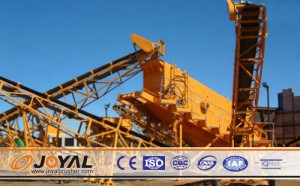

Treatment and utilization of coal gangue
1. Recovery of coal and pyrite. Through simple techniques, from the gangue in the coal washing well chosen, selected by screening from low quality coal, and pick out of pyrite. Recovery of coal can be powered by fuel, washing waste rock can be used for building materials, and pyrite can be used for chemical raw materials.
2. Used for power generation.
3. Manufacture of building materials: bricks instead of clay as raw material can be dug less fertile. Brick, the use of coal fuel itself, can save coal.
4. Coal can also be used to produce low calorific value gas, manufacturing ceramics, making soil amendment, or used for paving, underground filling, filling the ground to create farmland. After the waste dump on the spontaneous combustion can also be planting grass, landscaping. Comparing with other traditional stone crusher, coal gangue crusher has excellences for fine crushing, high productions and low maintenance. The long force arm designed into the cone provides greater crushing force. And the spring release system generates more opposing force than other traditional stone crushers. So coal gangue crusher is used widely in coal gangue processing industry.
Talcum Basics
Talc is a mineral composed of hydrated magnesium silicate with the chemical formula H2Mg3 (SiO3)4 or Mg3Si4O10 (OH) 2. In loose form, it is the widely-used substance known as talcum powder. It occurs as foliated to fibrous masses, its monoclinic crystals being so rare as to be almost unknown. It has a perfect basal cleavage, and the folia are non-elastic, although slightly flexible. It is very soft and sectile (can be cut with a knife); as the defining mineral for the value of 1 on Mohs hardness, it can be easily scratched by a fingernail. It has a specific gravity of 2.5–2.8, a clear or dusty luster, and is translucent to opaque. Talc is not soluble in water, but it is slightly soluble in dilute mineral acids. Its colour ranges from white to grey or green and it has a distinctly greasy feel. Its streak is white. Soapstone is a metamorphic rock composed predominantly of talc.

Talc is used in many industries such as paper making, plastic, paint and coatings, rubber, food, electric cable, pharmaceuticals, cosmetics, ceramics, etc. A coarse grayish-green high-talc rock is soapstone or steatite and has been used for stoves, sinks, electrical switchboards, etc. It is often used for surfaces of lab counter tops and electrical switchboards because of its resistance to heat, electricity and acids. Talc finds use as a cosmetic (talcum powder), as a lubricant, and as filler in paper manufacture. Talc is used in baby powder, an astringent powder used for preventing rashes on the area covered by a diaper (see diaper rash). It is also often used in basketball to keep a player’s hands dry. Talc is also used as food additive or in pharmaceutical products as a glidant. Talc is widely used in the ceramics industry in both bodies and glazes.